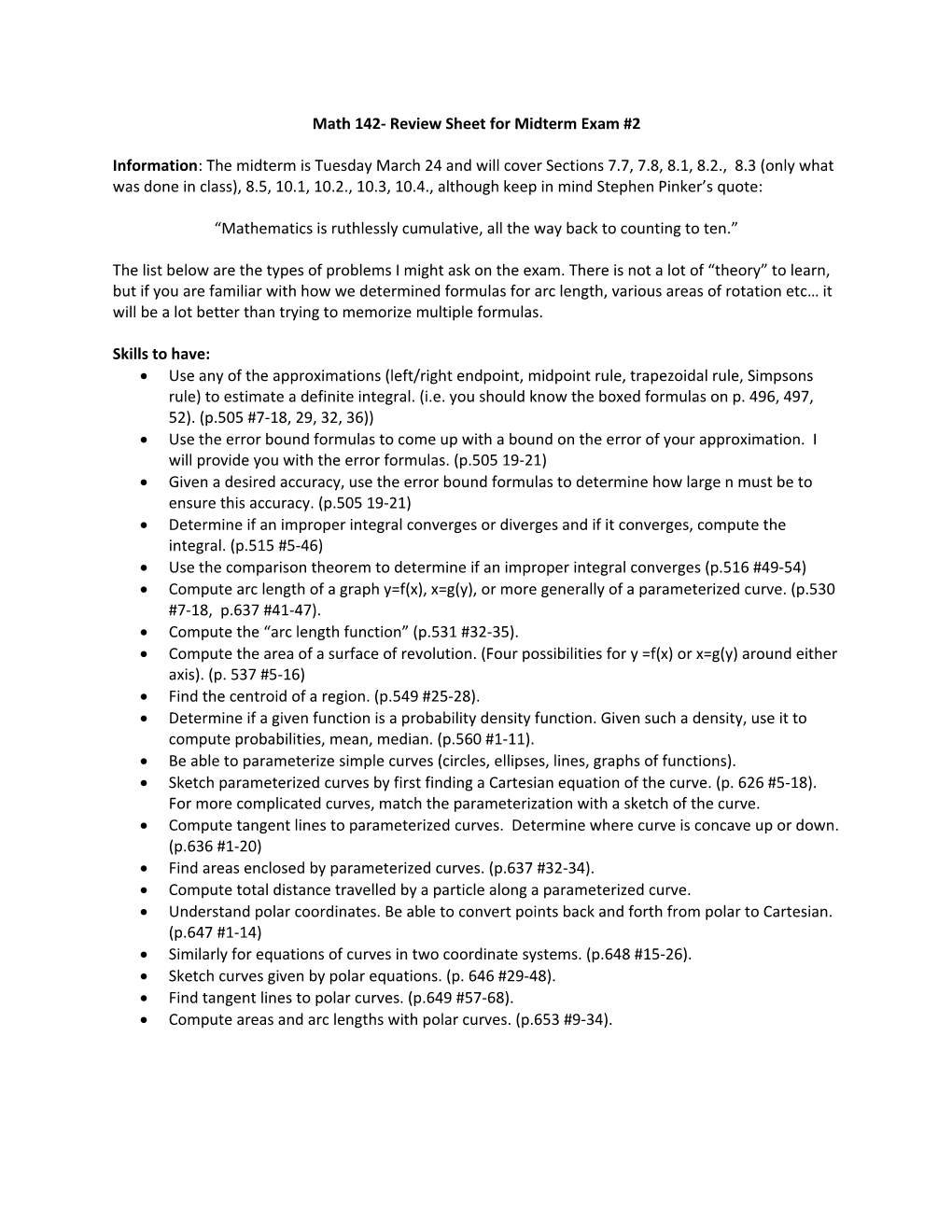Math 142- Review Sheet for Midterm Exam #2
Information: The midterm is Tuesday March 24 and will cover Sections 7.7, 7.8, 8.1, 8.2., 8.3 (only what was done in class), 8.5, 10.1, 10.2., 10.3, 10.4., although keep in mind Stephen Pinker’s quote:
“Mathematics is ruthlessly cumulative, all the way back to counting to ten.”
The list below are the types of problems I might ask on the exam. There is not a lot of “theory” to learn, but if you are familiar with how we determined formulas for arc length, various areas of rotation etc… it will be a lot better than trying to memorize multiple formulas.
Skills to have:
· Use any of the approximations (left/right endpoint, midpoint rule, trapezoidal rule, Simpsons rule) to estimate a definite integral. (i.e. you should know the boxed formulas on p. 496, 497, 52). (p.505 #7-18, 29, 32, 36))
· Use the error bound formulas to come up with a bound on the error of your approximation. I will provide you with the error formulas. (p.505 19-21)
· Given a desired accuracy, use the error bound formulas to determine how large n must be to ensure this accuracy. (p.505 19-21)
· Determine if an improper integral converges or diverges and if it converges, compute the integral. (p.515 #5-46)
· Use the comparison theorem to determine if an improper integral converges (p.516 #49-54)
· Compute arc length of a graph y=f(x), x=g(y), or more generally of a parameterized curve. (p.530 #7-18, p.637 #41-47).
· Compute the “arc length function” (p.531 #32-35).
· Compute the area of a surface of revolution. (Four possibilities for y =f(x) or x=g(y) around either axis). (p. 537 #5-16)
· Find the centroid of a region. (p.549 #25-28).
· Determine if a given function is a probability density function. Given such a density, use it to compute probabilities, mean, median. (p.560 #1-11).
· Be able to parameterize simple curves (circles, ellipses, lines, graphs of functions).
· Sketch parameterized curves by first finding a Cartesian equation of the curve. (p. 626 #5-18). For more complicated curves, match the parameterization with a sketch of the curve.
· Compute tangent lines to parameterized curves. Determine where curve is concave up or down. (p.636 #1-20)
· Find areas enclosed by parameterized curves. (p.637 #32-34).
· Compute total distance travelled by a particle along a parameterized curve.
· Understand polar coordinates. Be able to convert points back and forth from polar to Cartesian. (p.647 #1-14)
· Similarly for equations of curves in two coordinate systems. (p.648 #15-26).
· Sketch curves given by polar equations. (p. 646 #29-48).
· Find tangent lines to polar curves. (p.649 #57-68).
· Compute areas and arc lengths with polar curves. (p.653 #9-34).
